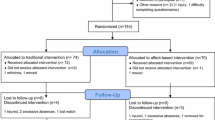Abstract
The purpose of the study is to evaluate the performance of theoretically-derived mediators of health behavior change. Participants were university seniors (184 females; 154 males) randomly assigned to an intervention course designed to promote physical activity or to a control course. Five physical activity outcomes and nine psychosocial mediating variables were assessed at baseline and the end of the 16-week course. For women, the intervention had significant effects on five of the mediators, including self-efficacy for making time, self-efficacy for resisting relapse, social support from friends, and experiential and behavioral processes of change. Among men, the intervention improved use of behavioral processes of change but also had the unintended effect of increasing perceived barriers to activity. For women, significant contributors to regressions explaining physical activity change were social support from friends (for total activity) and change in self-efficacy for resisting relapse (for vigorous exercise). For men, significant explanatory variables included change in enjoyment (for total activity), change in self-efficacy for resisting relapse (for strength exercise), and change in benefits (for moderate intensity activity). For both sexes, there were significant findings in the unexpected direction. Across the five physical activity outcomes, hypothesized mediators were inconsistent and weak contributors to the models. Investigating mediators of behavior change has the potential to stimulate improvements in theories and interventions.
Similar content being viewed by others
References
Dishman RK, Buckworth J: Increasing physical activity: A quantitative synthesis.Medicine and Science in Sports and Exercise. 1996,28:706–719.
Baranowski T, Lin LS, Wetter DW, Resnicow K, Hearn MD: Theory as mediating variables: Why aren't community interventions working as desired?Annals of Epidemiology. 1997,S7:S89-S95.
Bandura A:Social Foundations of Thought and Action. Englewood Cliffs, NJ: Prentice-Hall, 1986.
Prochaska JO, Marcus BH: The transtheoretical model: Applications to exercise. In Dishman RK (ed),Advances in Exercise Adherence. Champaign, IL: Human Kinetics, 1994, 161–180.
Bandura A:Self-Efficacy: The Exercise of Control. New York: Freeman, 1998.
Dishman RK, Sallis JF: Determinants and interventions for physical activity and exercise. In Bouchard C, Shephard RJ, Stephens T (eds),Physical Activity, Fitness, and Health: International Proceedings and Consensus Statement. Champaign, IL: Human Kinetics, 1994, 214–238.
U.S. Department of Health and Human Services:Physical Activity and Health: A Report of the Surgeon General. Atlanta, GA: Centers for Disease Control and Prevention, 1996.
Marcus BH, Rakowski W, Rossi JS: Assessing motivational readiness and decision making regarding exercise.Health Psychology. 1992,11:257–261.
Calfas KJ, Sallis JF, Oldenburg B, Ffrench M: Mediators of change in physical activity following an intervention in primary care: PACE.Preventive Medicine. 1997,26:297–304.
Castro CM, Sallis JF, Hickman SA, Lee RE, Chen AH: A prospective study of psychosocial correlates of physical activity for ethnic minority women.Psychology and Health. 1999,14:277–293.
Pate RR, Pratt M, Blair SN, et al: Physical activity and public health: A recommendation from the Centers for Disease Control and Prevention and the American College of Sports Medicine.Journal of the American Medical Association. 1995,273:402–407.
U.S. Department of Health and Human Services, Public Health Service:Healthy People 2000: National Health Promotion and Disease Prevention Objectives, DHHS Publication No. (PHS) 9150212. Washington, DC: U.S. Government Printing Office, 1991.
Sallis JF, Calfas KJ, Nichols JF, et al: Evaluation of a university course to promote physical activity: Project GRAD.Research Quarterly for Exercise and Sport. 1999,70:1–10.
Sarkin JA, Marshall SJ, Larson KA, Sallis JF, Calfas KJ: A comparison of recruitment methods to a health promotion program for university seniors.Preventive Medicine. 1998,27:562–571.
Marcus BH, Simkin LR: The stages of exercise behavior.Journal of Sports Medicine and Physical Fitness. 1993,33:83–88.
Blair SN: How to assess exercise habits and physical fitness. In Matarazzo JD, Herd JA, Miller NE, Weiss SM (eds),Behavioral Health: A Handbook of Health Enhancement and Disease Prevention. New York: Wiley, 1984, 424–447.
Gross LD, Sallis JF, Buono MJ, Roby JA, Nelson JA: Reliability of interviewers using the seven-day physical activity recall.Research Quarterly for Exercise and Sport. 1990,61:321–325.
Montoye HJ, Kemper HCG, Saris WHM, Washburn RA: Measuring physical activity and energy expenditure. Champaign, IL: Human Kinetics, 1996.
Sarkin J, Campbell J, Gross L, et al: Project GRAD Seven-Day Physical Activity Recall Interviewer's Manual.Medicine and Science in Sports and Exercise. 1997,29(Suppl.):S91-S102.
Sallis JF, Pinski RB, Grossman RM, Patterson TL, Nader PR: The development of self-efficacy scales for health-related diet and exercise behaviors.Health Education Research Theory and Practice. 1988,3:283–292.
Sallis JF, Grossman RM, Pinski RB, Patterson TL, Nader PR: The development of scales to measure social support for diet and exercise behaviors.Preventive Medicine. 1987,16:825–836.
Sallis JF, Hovell MF, Hofstetter CR, et al: A multivariate study of determinants of vigorous exercise in a community sample.Preventive Medicine. 1989,18:20–34.
Marcus BH, Rossi JS, Selby VC, Niaura RS, Abrams DB: The stages and processes of exercise adoption and maintenance in a worksite sample.Health Psychology. 1992,11:386–395.
Kendzierski D, Decarlo KJ: Physical activity enjoyment scale: Two validation studies.Journal of Sport and Exercise Psychology. 1991,13: 50–64.
Baron RM, Kenny DA: The moderator-mediator variable distinction in social psychological research: Conceptual, strategic, and statistical considerations.Journal of Personality and Social Psychology. 1986,51:1173–1182.
Sallis JF, McKenzie TL, Alcaraz JE, et al: The effects of a 2-year physical education program (SPARK) on physical activity and fitness in elementary school students.American Journal of Public Health. 1997,87:1328–1334.
Stone EJ, Baranowski T, Sallis JF, Cutler JA: Synthesis of behavioral research for cardiopulmonary health: Emphasis on youth, gender, and ethnicity.Journal of Health Education. 1995,26:S9-S17.
Sallis JF, Hovell MF, Hofstetter CR, Barrington E: Explanation of vigorous physical activity during two years using social learning variables.Social Science and Medicine. 1992,34:25–32.
Author information
Authors and Affiliations
Additional information
Preparation of this manuscript was supported in part by NIH grant HL49505.
About this article
Cite this article
Sallis, J.F., Calfas, K.J., Alcaraz, J.E. et al. Potential mediators of change in a physical activity promotion course for university students: Project grad. ann. behav. med. 21, 149–158 (1999). https://doi.org/10.1007/BF02908296
Issue Date:
DOI: https://doi.org/10.1007/BF02908296




